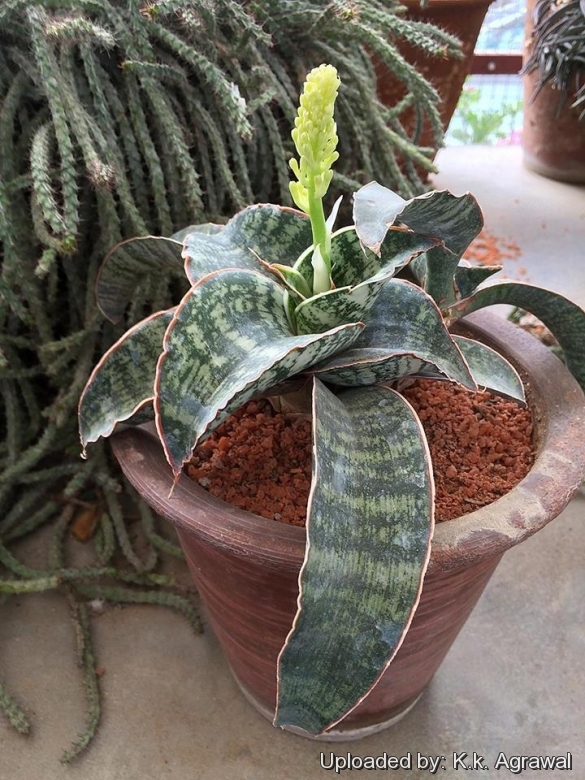Accepted Scientific Name: Sansevieria cv. Horwood
Cact. Succ. J. (Los Angeles) 60(6): 251, fig. 1, 1988

Sansevieria elliptica cv. Horwood (Sansevieria cv. Horwood) Photo by: K.k. Agrawal
Origin and Habitat: Sansevieria 'Horwood' was named by Grigsby based on the collection Frank Horwood # FKH 424 which is without locality data but believed to be from Kenya. Identical plants were collected 10 km northwest of Kibwezi on the Nairobi-Mombasa road by Juan Chahinian in 1992. The name Sansevieria horwoodii has become widespread in the horticultural trade but has never been formally published. Further collections which appear to belong here were made by G. Powys in Malka Mari National Park in NE Kenya close to the border with Ethiopia , and by R. Martin at Muratate in Kenya (not located).
Synonyms:
Description: Sansevieria ‘Horwood’ (called by some Sansevieria elliptica ‘Horwood’) is a very attractive stemless plant with dramatic green leaves with grey-white mottling, rough on the underside. The flattened leaves of great thickness, give it, too, an extremely distinctive look. The spectacular inflorescence reaches about 70 cm in length, and the flowers are nice too.
Leaves: Usually 2-5 per growth, up to 75 cm long, 7.5 cm wide spreading in all directions, sometimes up to 8 or more in a rosette, rigid, lanceolate to oval, thick and wide in the middle, held more or less horizontally, sometimes twisted, with a tapered tip. Upper surface smooth, but not glossy and leathery, dark green, slightly bluish in young leaves, with shades of grey in the form of whitish or silver green spots and there are also dark green longitudinal lines. Leaf edge red, extending on both sides of the leaf surface.
Inflorescence: Flower stalk rather thick up to 60-70 cm tall with small leaves
Similar species: This cultivar is small slow-growing form that seems to have some relation to Sansevieria kirkii in the stout broad leaves with red margins and prominent blotchy variegation and a relation to Sansevieria elliptica and Sansevieria angustifolia on the basis of its overall leaf shape (and possibly a form of Sansevieria forskaliana). There is also a similar species with purple leaf base, formerly known as Sansevieria conspicua. Jankalski places 'Horwood' under Sansevieria elliptica.
Bibliography: Major references and further lectures
1) Quelle: J. Chahinian - British Cactus & Succulent Journal No.2 [Vol12/June1994] pages 68-72
2) Chahinian,B.J. “A Sansevieria Safari.” The Sansevieria Journal 2 (2): 35; 2 (3): 62; 2(4): 82-86; 3 (1): 10-15; 3 (2): 34-38. 1993-94
3) Chahinian, “The Splendid Sansevieria” p. 69 2005
4) Grigsby, D.B. ”Sansevieria 'Horwood', a New Cultivar.” Cact. & Succ.Journ. Amer. 60(6): 251, fig. 1, 1988
5) Teketay, D. “The genus Sansevieria Thunb. in Ethiopia. a contribution to the Flora of Ethiopia”. The Sansevieria Journal 4 (2): 43-58, 4 figs. 1995
6) Thulin, M. “Dracaenaceae. Flora of Somalia” 4: 27-30, fig. 18. 1995
7) Jankalski Sansevieria No. 7: 26, 2003
8) G. Powys Sansevieria No. 13: 10, 2005
9) R. Martin Sansevieria No. 11: 11, 2005
10)Redaksi Trubus “Sansevieria, 200 Jenis Spektakuler” Niaga Swadaya, 2008
11) M. Idariani Tahir, Maloedyn Sitanggang "165 Sansevieria Eksklusif" AgroMedia, 01 set 2008
 Sansevieria elliptica cv. Horwood (Sansevieria cv. Horwood) Photo by: K.k. Agrawal
Sansevieria elliptica cv. Horwood (Sansevieria cv. Horwood) Photo by: K.k. AgrawalSend a photo of this plant.The gallery now contains thousands of pictures, however it is possible to do even more. We are, of course, seeking photos of species not yet shown in the gallery but not only that, we are also looking for better pictures than those already present.
Read More... Cultivation and Propagation: Sansevieria cv. HorwoodSN|31266]]SN|31266]] is one of the slowest of the Sansevierias to grow but easy to cultivate and tolerate a wide range of conditions. It is a very drought tolerant plant, but not as cold hardy as some. It needs heat and dry air in Winter and half shade in Summer. Does best as a pot plant.
Soil: Use a soil mix consisting of 3 parts loam to 1 part of pumice.
Fertilization: They are fertilized once during the growing season with a balanced fertilizer.
Watering Needs: The plants are very drought tolerant and are watered about every other week during the growing season. During the winter months they are watered once a month. Water sparingly and not at all as temperatures dip in winter if growing outdoors - can tolerate going months between watering.
Exposure: Will tolerate low light levels but grows best and flowers if given bright light and even tolerates full sun. Afternoon shade in summer.
Frost Tolerance: Avoid any frost. This species is dormant in winter, keep it at or around 4°C.
Outdoors: In the garden In mild to tropical climates it prefers semi-shade or shade and it is not fussy.
Use: It is a great container plant for interior or exterior use that needs little care. It makes a choice designer's architectural statement. It is popular as an ornamental plant as it is easy to culture and take care of in a home.
Warnings: It is toxic (has oxylates that cause oral and throat irritation) if chewed or eaten.
Propagation: They are propagated by cuttings or by divisions taken at any time. Cuttings should be at least 10 cm long and inserted in moist sand. A rhizome will emerge at the cut edge of the leaf.












